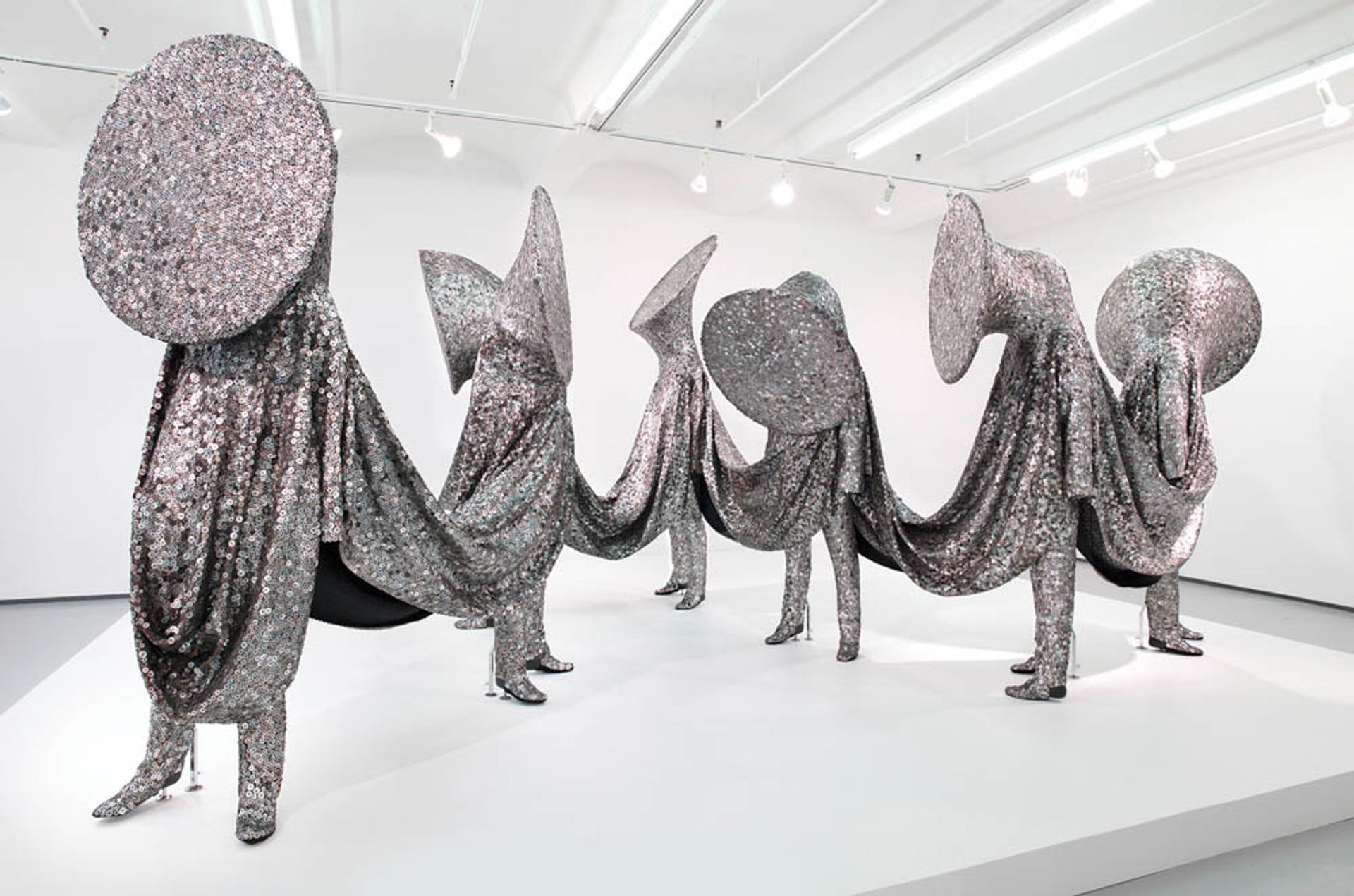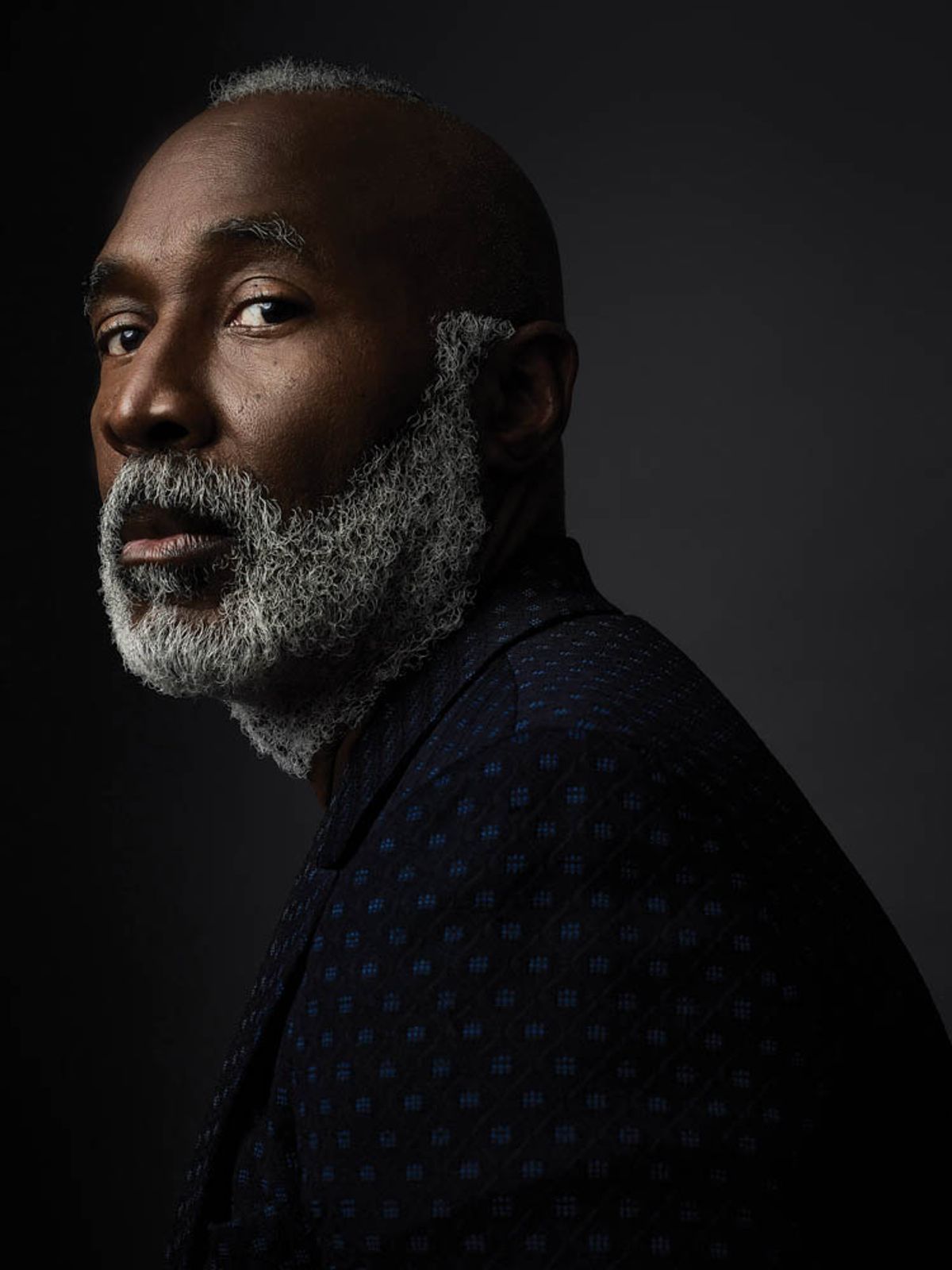Nick Cave first came to Chicago in 1990, when he was hired to teach fashion design at the School of the Art Institute of Chicago, a department he would later direct. He has lived and worked in the city since then, developing a body of work that merges costume, performance and social action. He is perhaps best known for his Soundsuits, a series (now numbering in the hundreds) of wearable works that serve as both adornment and armour, built from found objects and materials, and often activated through whirling dervish-like performances. The first Soundsuit was created in 1992, as a response to Rodney King’s beating by Los Angeles police; his most recent ones were made after the killing of George Floyd in 2020.
Cave’s first major museum retrospective, Forothermore, opens at the Museum of Contemporary Art (MCA) Chicago next month. A version of the exhibition will open later this year at the Guggenheim Museum in New York, where the show’s curator, Naomi Beckwith, has taken up the post of deputy director.
The Art Newspaper: This exhibition includes elements of your previous projects and there are other presentations of your work around Chicago, including a projection on the Merchandise Mart building and a fashion performance with your brother Jack Cave at the DuSable Museum, in the Roundhouse. It’s a big moment for you.
Nick Cave: When I think about this moment and how it’s allowing me to look back at my career, at the work, it’s interesting that I keep coming to this place of light. And I realised that I have been, for the last three decades, trying to bring light to the subject of racism and inequality. It just all of a sudden made sense—that through my craft, that has really been the mission. Using that as a catalyst to reach and connect to community.
I’m always trying to think about connections and reconnecting and how we work within the civic construct. I’m interested in partnerships, I’m interested in inclusion and how I can expand that. How do I think about what has been going on at the MCA around all of that, and what role and responsibilities do I have in helping shift that narrative? This is why these moments are being created.

Speak Louder (2011), made from materials including black mother-of-pearl buttons and metal armature, gathering seven of the artist’s signature Soundsuit sculptures. Cave created his first Soundsuit in
1992 in response the beating of Rodney King by Los Angeles police. © Nick Cave. Courtesy of the artist and Jack Shainman Gallery. Photo: James Prinz Photography.
And I’ve always been connected to fashion. I had a retail store for a decade [in the 1990s]. And I’ve been thinking lately about returning to that in some aspect—that after every solo project, I would do a response through garments. It may be a capsule collection of maybe nine pieces. I’m interested in that because of the influence of my work in the fashion industry and designers that are looking at the work as a source of reference and inspiration. So I thought, “How would I approach a collection?”
The idea [for the performance] came from this sequence in [the 1978 film] The Wiz, where they are parading, processionally, in these fashions in the round. That was the catalyst and the Roundhouse is a perfect setting. It’s accompanied by a musical performance by [all-women doo-wop group] Labelle. And we’re working with 80 local individuals here in the city [who will present the garments]—some students, some assistants, but we’ve been doing an open call for performers.
Have you and your brother collaborated before?
We’ve always been interested in these ideas around fashion, collection, performance. But he chose to take the design route for a career path and I chose the art route. When I said, “Oh, by the way, do you want to collaborate on this fashion performance?” he was like, “Oh my God.” So, this is this moment that we’ve always thought about.
The exhibition looks back at your entire career up to now. There are works from 1989, after you finished your MFA at Cranbrook Academy of Art. What was it like revisiting those earliest pieces?
As a young artist, residencies would come up, and I would just grab my backpack, take nothing with me, figure it out when I got there. That’s how I was able to expand on my material language. I would think, “Well, what am I going to do for five months here?” That shifted my practice in terms of seeking out what’s in the surroundings and finding what I need in order to make a point of view. What is the material language that will support that? So that was the beginning of me working with the found object and the discarded. You’ll see this body of work that is about the idea of gathering and that process building the work. And they’re some of the same principles I follow today.
Some of those older works—three out of the five pieces—are still in my personal collection. It was the beginning of this journey. And as a young artist, we don’t know what that looks like, we don’t know how that’s going to play out. I think it’s bigger than oneself. I mean, I am here because I’m supposed to be. That’s all I can really say.
Time and Again, one of those early works that’s going to be at the MCA, has a very personal connection to your family history.
During that period, my first grandfather had passed—and we are a very close-knit family, so that was the beginning of me responding to that loss. Both my grandfathers were craftsmen, so it’s paying homage to a part of my upbringing that was crucial, to be surrounded by these amazing makers, and to honour that.
As you go through the show, you’ll see these markers that triggered a shift in direction in the work, based on what was going on within my life at that time. You’ll find there are these critical works that allowed me to respond. I think about that when I look at Time and Again, when I look back at the first Soundsuits, and then I look at TM 13, which is the Trayvon Martin piece.
Art has always been my saviour; it has allowed me to vent and to work through these difficult moments through this vernacular.
You also recently opened Facility near Irving Park, your new studio and community space.
I’d been looking for a property for, oh my God, it was maybe five years until I found something that would work. It’s really about zoning at the end of the day, you can get so far in the process and if the zoning will not change to live-work, then the deal is off. And so I found the building, and it houses my studio, as well as studios for my partner Bob Faust and my brother Jack Cave. But it’s also a space where we invite artists to come and do projects. We have storefront galleries where we can create exhibitions that we don’t have to open up Facility in order for you to view them.
Over the past year, you’ve had MFA students show their design projects there, when the Art Institute wasn’t able to hold their thesis shows.
When Covid hit, their whole thesis was cancelled. And I thought, “Oh my God, these kids are devastated.” Luckily, we had this building, and we were able to secure each of them a one-month exhibition in the windows. But then we’ve also used it in response to George Floyd. We did a project called Amends. And now again, we’re able to turn it into a working studio. Then after that, Katrin Schnabel will have an exhibition in the space. So again, the ability to have that flexibility, and for it to be this evolving and revolving space, is what it’s really about.
Amends involved members of the community confessing and apologising for their own personal experiences in perpetuating racism, with a connected installation, Dirty Laundry, across the street at the Carl Schurz High School.
Amends, on the storefront windows, was where we invited a group of collectors and art professionals to write letters to the world around racism. And again, to be able to have the community to have access to that was important. And then we worked with the public high school across the street to use their front lawn to continue this project. All of Chicago could come and write their amend on a yellow ribbon and then hang it on this line that extended across the lawn, which was massive. And it was amazing. And that’s always been a real big part of my practice. I’m an artist with a civic responsibility.
And what’s next for you?
I think you’ll see the beginning of that in the show. It closes with my first bronze Soundsuit. That work started before the dismantling of all these monuments. It really comes out of me thinking about the world outside of institutions, being able to put the work out in the world, and for me to be able to create these 20-ft bronze Soundsuits that could be accessible to anyone.
• Nick Cave: Forothermore, Museum of Contemporary Art Chicago, 14 May-2 October. Nick Cave: The Color Is, 21 May, DuSable Museum of African American History Roundhouse, Chicago. Drive-By, Art on theMART, Chicago, 5 May-7 September
Biography
Born: 1959 Fulton, Missouri
Lives: Chicago
Education:1989 MFA, Cranbrook Academy of Art, Bloomfield Hills; 1986 Graduate Studies, North Texas State University, Denton; 1982 BFA, Kansas City Art Institute
Key shows: 2017-20 Feat, The Frist Center for the Visual Arts, Nashville; Orlando Museum of Art; Akron Art Museum; Glenbow Museum, Calgary 2016–21 Until, Massachusetts Museum of Contemporary Art; Carriageworks, Sydney; Tramway, Glasgow; Crystal Bridges Museum of American Art, Bentonville 2013 The World is My Skin, Trapholt Museum, Kolding, Denmark 2009-12 Meet Me at the Center of the Earth, Yerba Buena Center for the Arts, San Francisco; Scottsdale Museum of Contemporary Art; Fowler Museum, Los Angeles; Norton Museum, West Palm Beach; Seattle Art Museum; Taubman Museum of Art, Roanoke; Cincinnati Art Museum; Boise Art Museum
Represented by: Jack Shainman, New York


